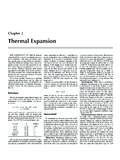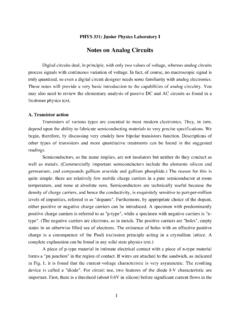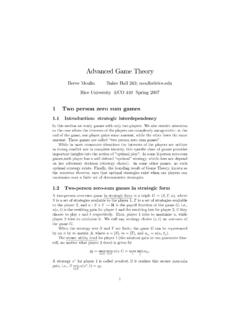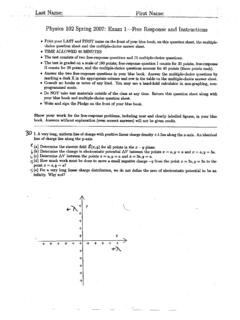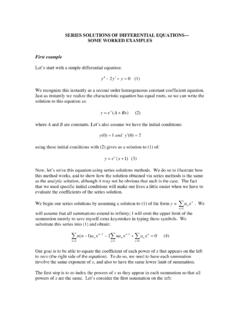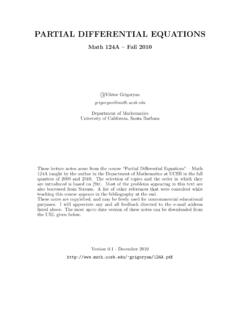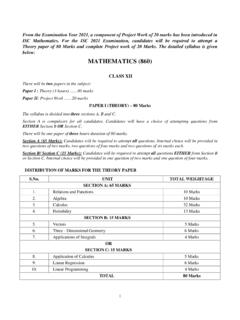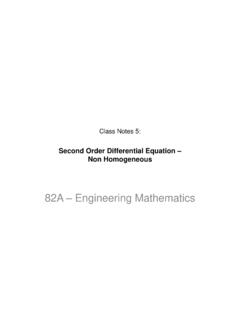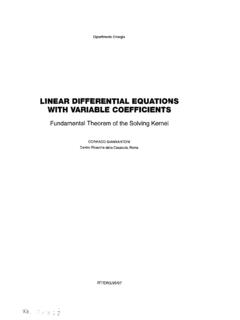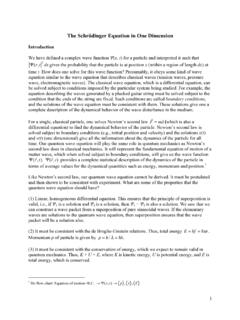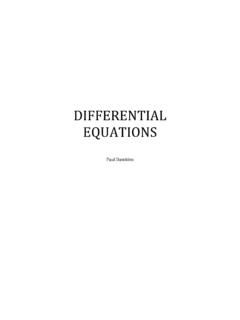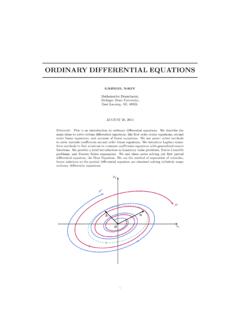Transcription of Chapter 7 Solution of the Partial Differential Equations
1 Chapter 7 Solution of the Partial Differential Equations Classes of Partial Differential Equations Systems described by the Poisson and Laplace equation Systems described by the diffusion equation Greens function, convolution, and superposition Green's function for the diffusion equation Similarity transformation Complex potential for irrotational flow Solution of hyperbolic systems Classes of Partial Differential Equations The Partial Differential Equations that arise in transport phenomena are usually the first order conservation Equations or second order PDEs that are classified as elliptic, parabolic, and hyperbolic.
2 A system of first order conservation Equations is sometimes combined as a second order hyperbolic PDE. The student is encouraged to read R. Courant, Methods of Mathematical Physics, Volume II Partial Differential Equations , 1962 for a complete discussion. System of conservation laws. Denote the set of dependent variables ( , velocity, density, pressure, entropy, phase saturation, concentration) with the variable u and the set of independent variables as t and x, where x denotes the spatial coordinates.
3 In the absence of body forces, viscosity, thermal conduction, diffusion, and dispersion, the conservation laws (accumulation plus divergence of the flux and gradient of a scalar) are of the form 112121212()()()()where(,,)(,,,),Jacobian matrix(,,,)(,,,)nnnnguguf uufufuttxtgxgggffffguuuuuu + =+= + = i"""" This is a system of first order quasilinear hyperbolic PDEs. They can be solved by the method of characteristics. These Equations arise when transport of material or energy occurs as a result of convection without diffusion.
4 The derivation of the Equations of motion and energy using convective coordinates (Reynolds transport theorem) resulted in Equations that did not have the accumulation and convective terms in the form of the conservation laws. However, by derivation of the Equations with fixed coordinates (as in Bird, Stewart, and Lightfoot) or by application of the continuity equation, the momentum and energy Equations can be transformed so that the accumulation and convective terms are of the form of conservation laws.
5 Viscosity and thermal conductivity introduce second derivative terms that make the system non-conservative. This transformation is illustrated by the following relations. 7-1 ()()()()()()()()0,continuityequation,for ,, orDDttDFFFFSEDttFFFtttFFFFFFDFFFFFDtttFF FttDFDtF + =+ = =+ = =+ = + = + + = + =+ + + =vvvvvvvvvvvvvvvv() (), + v Assignment (a) For the case of inviscid, nonconducting fluid, in the absence of body forces, derive the steps to express the continuity equation, Equations of motion, and energy Equations as conservation law Equations for mass, momentum, the sum of kinetic plus internal energy, and entropy.
6 (b) For the case of isentropic, compressible flow, express continuity equation and Equations of motions in terms of pressure and velocity. Transform it to a second order hyperbolic equation in the case of small perturbations. second order PDE. The classification of second order PDEs as elliptic, parabolic, and hyperbolic arise from a transformation of the independent variables. The classification apply to quasilinear ( , linear in the highest order derivatives) but we will only discuss linear Equations with constant coefficients here.
7 Numerical solutions are needed for quasilinear systems. Again let u denote the dependent variables and t, x, y, z as the independent variables. Examples of the different classes of Equations are 222222222222222222222220,ellipticequatio n,parabolic equation,hyperbolic equatiouuuuxyzuuuuutxyzuuuuuntxyz =+++= + =+++= + =+++= + . The term represents sources. When the cgs system of units is used in electrostatics and is the charge density, the source is expressed as 4.
8 The factor 4 is absent with the mks or SI system of units. The parabolic PDEs 7-2are sometimes called the diffusion equation or heat equation. In the limit of steady-state conditions, the parabolic Equations reduce to elliptic Equations . The hyperbolic PDEs are sometimes called the wave equation. A pair of first order conservation Equations can be transformed into a second order hyperbolic equation. Convective-diffusion equation. The above Equations represented convection without diffusion or diffusion without convection.
9 When both the first and second spatial derivatives are present, the equation is called the convection-diffusion equation. 221uuutxNx += Usually a dimensionless group such as the Reynolds number, or Reynolds number and Prandtl number appears as a factor to quantify the relative contribution of convection and diffusion. Systems described by the Poisson and Laplace equation We saw earlier that an irrotational vector field can be expressed as the gradient of a scalar and if in addition the vector field is solenoidal, then the scalar potential is the Solution of the Laplace equation.
10 22,irrotationalflow0,incompressible, irrotational flow = = = = = vvv Also, if the velocity field is solenoidal then the velocity can be expressed as the curl of the vector potential and the Laplacian of the vector potential is equal to the negative of the vorticity. If the flow is irrotational, then the vorticity is zero and the vector potential is a Solution of the Laplace equation. 2222,incompressible flow,for0,in twodimensions0,irrotational flow and00,fortwodimensional, irrotational, incompressible floww = = = = = = = = =vAvwAAvAA Other systems, which are Solution of the Laplace equation, are steady state heat conduction in a homogenous medium without sources and in electrostatics and static magnetic fields.
